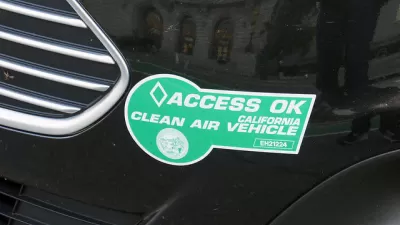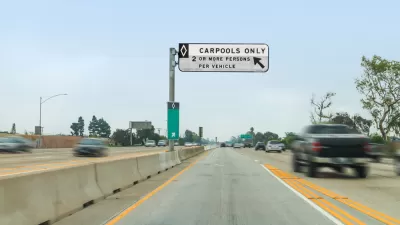One of the major reasons for purchasing an electric vehicle in California is the ability to use a carpool lane as a solo driver and use an express lane toll-free. The latter perk will soon disappear for solo-occupant EVs on two freeways.

"In a bid to reduce congestion in toll lanes on the 110 and 10 freeways, Los Angeles County transportation officials on Thursday opted to end a program granting solo drivers of zero-emission vehicles free access to the lanes," reports Laura J. Nelson, who covers transportation and mobility issues across Southern California for the Los Angeles Times, on April 26. Many near-zero-emission vehicles also qualify for the California Clean Air Decal program.
Drivers with state-issued clean-air stickers will be charged a toll starting in November or December of this year, [Los Angeles County] Metropolitan Transportation Authority [Metro] officials said. They will receive a 15% discount on the per-mile toll lane price.
Metro officials said the policy is necessary to keep speeds in the lanes above the federally mandated minimum of 45 mph during rush hour. When it comes to taming congestion, they say, a zero-emission car with one occupant is no different from any other vehicle.
The two freeways have had an oversubscription problem that developed a few years after the roads' high occupancy vehicle (HOV) lanes were converted in November 2012 to high occupancy toll (HOT) lanes, aka express lanes, to allow access by single-occupant vehicles which would pay a toll that varied with congestion levels. The one-year, federally financed (see "NYC's Loss May Be LA's Gain") congestion pricing pilot project proved too much of a success.
Tolls on the Harbor Freeway (I-110) and San Bernardino Freeway (I-10) fluctuate between 35 cents to $2 per mile during rush hour, based on how many drivers are in the paid lanes...Under the previous policy, such incentives held no sway over drivers of zero-emission vehicles.
The share of zero-emission vehicles in the lanes has doubled to 6% in the last two years, Metro said. The number of clean-air decals issued statewide by the Department of Motor Vehicles grew 44% between the end of 2016 and March 1, to more than 320,000.
Opposition to ending the electric vehicle privilege
Interestingly, Metro initially proposed in 2011 to deny solo-occupant electric vehicles access to the new HOT lanes, but green car advocates won that fight.
Los Angeles Mayor and Metro Chair Eric Garcetti, who supported Thursday's motion, reminded electric vehicle (EV) owners that they will still be able to utilize the HOT lanes toll-free by doing what drivers of internal combustion vehicles do: "Just carpool." However, that didn't sit well with the Metro vice chair, Los Angeles County Supervisor Sheila Kuehl, the lone member of the board to oppose the action. She said "the decision shows Metro isn't prioritizing the environment," reports Nelson. Others in the environmental community agree.
Metro's change to the toll policy has drawn some criticism from environmental advocates, who say saving time and money is a major reason that Los Angeles County residents buy zero-emission cars. Reducing emissions from transportation is critical to meeting the state's air quality and climate goals.
[Kuehl] also cited a recent UCLA study that found the ability to drive alone in a carpool lane or a toll lane is the "single biggest incentive" for Californians to buy a zero-emission vehicle if they live within 10 miles of such a lane.
The decision to remove the valuable perk bears similarity to another policy decision affecting the expense of operating electric vehicles. Many states, including California, have proposed policies of charging annual registration fees to electric vehicles to compensate for the fact that they pay no gas taxes, and thus don't contribute to road upkeep. EV fees have become very controversial with some environmental groups. A U.S. Department of Energy listing from 2015 lists nine states, but many states have been added since then.
Another way to deal with mitigating the congestion in the express lanes to maintain minimum travel speeds of 45 mph is to "uncap" the toll rates. One of the nation's best examples are the 66 Express Lanes Inside the Beltway in northern Virginia. On day two of operation last December, the tolls topped $40 for the morning, eastbound trip to Washington. And how does the operator of those lanes, the Virginia Department of Transportation, deal with clean air vehicles, what they generically call hybrid vehicles?
They did not grant the privilege of toll-free travel to vehicles with Clean Special Fuel plates, which had been using the HOV lanes as solo-occupant vehicles, after they were converted to HOT lanes in December, though they retained that privilege with other toll lanes in the state. As Mayor Garcetti indicated, if EV drivers want to avoid paying tolls on the 66 Express Lanes, they need to carpool, like other motorists.
FULL STORY: Commuters who drive alone in zero-emission cars will no longer get free trips in L.A.'s toll lanes

Planetizen Federal Action Tracker
A weekly monitor of how Trump’s orders and actions are impacting planners and planning in America.

Chicago’s Ghost Rails
Just beneath the surface of the modern city lie the remnants of its expansive early 20th-century streetcar system.

San Antonio and Austin are Fusing Into one Massive Megaregion
The region spanning the two central Texas cities is growing fast, posing challenges for local infrastructure and water supplies.

Since Zion's Shuttles Went Electric “The Smog is Gone”
Visitors to Zion National Park can enjoy the canyon via the nation’s first fully electric park shuttle system.

Trump Distributing DOT Safety Funds at 1/10 Rate of Biden
Funds for Safe Streets and other transportation safety and equity programs are being held up by administrative reviews and conflicts with the Trump administration’s priorities.

German Cities Subsidize Taxis for Women Amid Wave of Violence
Free or low-cost taxi rides can help women navigate cities more safely, but critics say the programs don't address the root causes of violence against women.
Urban Design for Planners 1: Software Tools
This six-course series explores essential urban design concepts using open source software and equips planners with the tools they need to participate fully in the urban design process.
Planning for Universal Design
Learn the tools for implementing Universal Design in planning regulations.
planning NEXT
Appalachian Highlands Housing Partners
Mpact (founded as Rail~Volution)
City of Camden Redevelopment Agency
City of Astoria
City of Portland
City of Laramie





























